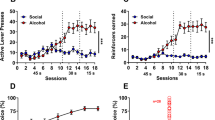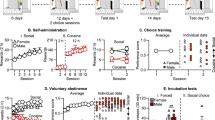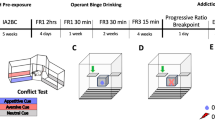Abstract
The interaction between social factors and alcohol addiction is complex, with potential for both positive and negative contributions to drug use and abstinence. Positive social connections are an important component in successful abstinence, and yet the social context of alcohol use can also lead to relapse. Recently it was shown that rats overwhelmingly choose social reward over methamphetamine, cocaine, and heroin in a discrete choice procedure, and that prolonged choice for social reward attenuates incubation of drug craving. The extent to which this effect generalises to rats trained to self-administer alcohol is not known. In this study we aimed to test the effect of social reward on choice for alcohol in male and female rats. We first validated social reward self-administration in both male and female Long-Evans rats, and found that 60 s access to a social partner of the same sex can serve as an operant reinforcer. Next we trained rats to self-administer both social reward and alcohol (20% ethanol in water), and then used discrete choice trial based tests to determine whether there is a choice preference for alcohol or social reward. Our main finding is that both male and female rats showed persistent choice for alcohol over social reward, with only minor differences between the sexes. We also show that choice for alcohol could be reduced via increased response requirement for alcohol, pre-choice alcohol exposure, and also decreasing the alcohol percentage. This study shows that preference for social rewards over drugs may not generalise to rats self-administering alcohol, and we describe several conditions where choice for social reward can be developed. This study highlights the important contribution of social factors to alcohol abuse, and future studies can investigate the neurobiology underlying a shift in preference from alcohol to social rewards.
Similar content being viewed by others
Log in or create a free account to read this content
Gain free access to this article, as well as selected content from this journal and more on nature.com
or
References
Azrin NH. Improvements in the community-reinforcement approach to alcoholism. Behav Res Ther. 1976;14:339–48.
Hunt GM, Azrin NH. A community-reinforcement approach to alcoholism. Behav Res Ther. 1973;11:91–104.
Havassy BE, Hall SM, Wasserman DA. Social support and relapse: commonalities among alcoholics, opiate users, and cigarette smokers. Addict Behav. 1991;16:235–46.
Marlatt GA, Baer JS, Donovan DM, Kivlahan DR. Addictive behaviors: etiology and treatment. Annu Rev Psychol. 1988;39:223–52.
Heilig M, Epstein DH, Nader MA, Shaham Y. Time to connect: bringing social context into addiction neuroscience. Nat Rev Neurosci. 2016;17:592–9.
Vanderschuren LJ, Achterberg EJ, Trezza V. The neurobiology of social play and its rewarding value in rats. Neurosci Biobehav Rev. 2016;70:86–105.
Venniro M, Zhang M, Caprioli D, Hoots JK, Golden SA, Heins C, et al. Volitional social interaction prevents drug addiction in rat models. Nat Neurosci. 2018;21:1520–9.
Venniro M, Russell TI, Zhang M, Shaham Y. Operant social reward decreases incubation of heroin craving in male and female rats. Biol Psychiatry. 2019;86:848–56.
Venniro M, Panlilio LV, Epstein DH, Shaham Y. The protective effect of operant social reward on cocaine self-administration, choice, and relapse is dependent on delay and effort for the social reward. Neuropsychopharmacology. 2021;46:2350–7.
Lenoir M, Serre F, Cantin L, Ahmed SH. Intense sweetness surpasses cocaine reward. PLoS ONE. 2007;2:e698.
Cantin L, Lenoir M, Augier E, Vanhille N, Dubreucq S, Serre F, et al. Cocaine is low on the value ladder of rats: possible evidence for resilience to addiction. PLoS ONE. 2010;5:e11592.
Augier E, Barbier E, Dulman RS, Licheri V, Augier G, Domi E, et al. A molecular mechanism for choosing alcohol over an alternative reward. Science. 2018;360:1321–6.
Russo M, Funk D, Loughlin A, Coen K, Le AD. Effects of alcohol dependence on discrete choice between alcohol and saccharin. Neuropsychopharmacology. 2018;43:1859–66.
Pelloux Y, Baunez C. Targeting the subthalamic nucleus in a preclinical model of alcohol use disorder. Psychopharmacology. 2017;234:2127–37.
Pennington ZT, Dong Z, Feng Y, Vetere LM, Page-Harley L, Shuman T, et al. ezTrack: an open-source video analysis pipeline for the investigation of animal behavior. Sci Rep. 2019;9:19979.
Simms JA, Steensland P, Medina B, Abernathy KE, Chandler LJ, Wise RA, et al. Intermittent access to 20% ethanol induces high ethanol consumption in Long–Evans and Wistar rats. Alcohol Clin Exp Res. 2008;32:1816–23.
Wise RA. Voluntary ethanol intake in rats following exposure to ethanol on various schedules. Psychopharmacology. 1973;29:203–10.
Baldwin AN, Banks ML, Marsh SA, Townsend EA, Venniro M, Shaham Y, et al. Acute pain-related depression of operant responding maintained by social interaction or food in male and female rats. Psychopharmacology. 2022;239:561–72.
Hart CL, Haney M, Foltin RW, Fischman MW. Alternative reinforcers differentially modify cocaine self-administration by humans. Behav Pharmacol. 2000;11:87–91.
Meisch RA. Oral drug self-administration: an overview of laboratory animal studies. Alcohol. 2001;24:117–28.
Caprioli D, Venniro M, Zeric T, Li X, Adhikary S, Madangopal R, et al. Effect of the novel positive allosteric modulator of mGluR 2 AZD8529 on incubation of methamphetamine craving after prolonged voluntary abstinence in a rat model. Biol Psychiatry. 2015;78:463–73.
Chow JJ, Beacher NJ, Chabot JM, Oke M, Venniro M, Lin DT, et al. Characterization of operant social interaction in rats: effects of access duration, effort, peer familiarity, housing conditions, and choice between social interaction vs. food or remifentanil. Psychopharmacology. 2022;239:2093–108.
Wolffgramm J, Heyne A. Social behavior, dominance, and social deprivation of rats determine drug choice. Pharmacol Biochem Behav. 1991;38:389–99.
Wolffgramm J, Heyne A. From controlled drug intake to loss of control: the irreversible development of drug addiction in the rat. Behavioural Brain Res. 1995;70:77–94.
Hopf FW, Chang SJ, Sparta DR, Bowers MS, Bonci A. Motivation for alcohol becomes resistant to quinine adulteration after 3 to 4 months of intermittent alcohol self-administration. Alcohol Clin Exp Res. 2010;34:1565–73.
Deroche-Gamonet V, Belin D, Piazza PV. Evidence for addiction-like behavior in the rat. Science. 2004;305:1014–7.
Lesscher HM, Spoelder M, Rotte MD, Janssen MJ, Hesseling P, Lozeman-van’t Klooster JG, et al. Early social isolation augments alcohol consumption in rats. Behav Pharmacol. 2015;26:673–80.
Bardo MT, Neisewander JL, Kelly TH. Individual differences and social influences on the neurobehavioral pharmacology of abused drugs. Pharmacol Rev. 2013;65:255–90.
Butler TR, Karkhanis AN, Jones SR, Weiner JL. Adolescent social isolation as a model of heightened vulnerability to comorbid alcoholism and anxiety disorders. Alcohol Clin Exp Res. 2016;40:1202–14.
Whitaker LR, Degoulet M, Morikawa H. Social deprivation enhances VTA synaptic plasticity and drug-induced contextual learning. Neuron. 2013;77:335–45.
Wukitsch TJ, Reinhardt EK, Kiefer SW, Cain ME. Voluntary ethanol consumption during early social isolation and responding for ethanol in adulthood. Alcohol. 2019;77:1–10.
Moench KM, Logrip ML. Housing condition differentially impacts escalation of alcohol intake, relapse-like drinking, anxiety-like behavior, and stress history effects by sex. Alcohol Clin Exp Res. 2021;45:480–9.
Wise RA, Leone P, Rivest R, Leeb K. Elevations of nucleus accumbens dopamine and DOPAC levels during intravenous heroin self-administration. Synapse. 1995;21:140–8.
Wise RA, Newton P, Leeb K, Burnette B, Pocock D, Justice JB Jr. Fluctuations in nucleus accumbens dopamine concentration during intravenous cocaine self-administration in rats. Psychopharmacology. 1995;120:10–20.
Canchy L, Girardeau P, Durand A, Vouillac-Mendoza C, Ahmed SH. Pharmacokinetics trumps pharmacodynamics during cocaine choice: a reconciliation with the dopamine hypothesis of addiction. Neuropsychopharmacology. 2021;46:288–96.
Vandaele Y, Cantin L, Serre F, Vouillac-Mendoza C, Ahmed SH. Choosing under the influence: a drug-specific mechanism by which the setting controls drug choices in rats. Neuropsychopharmacology. 2016;41:646–57.
Carroll ME. Oral self-administration of phencyclidine analogs by rhesus monkeys: conditioned taste and visual reinforcers. Psychopharmacol. 1982;78:116–20.
Carroll ME, Meisch RA. Concurrent etonitazene and water intake in rats: role of taste, olfaction, and auditory stimuli. Psychopharmacology. 1979;64:1–7.
Tomie A, Gittleman J, Dranoff E, Pohorecky LA. Social interaction opportunity and intermittent presentations of ethanol sipper tube induce ethanol drinking in rats. Alcohol. 2005;35:43–55.
Tomie A, Uveges JM, Burger KM, Patterson-Buckendahl P, Pohorecky LA. Effects of ethanol sipper and social opportunity on ethanol drinking in rats. Alcohol Alcohol. 2004;39:197–202.
Smith MA, Cha HS, Griffith AK, Sharp JL. Social contact reinforces cocaine self-administration in young adult male rats: the role of social reinforcement in vulnerability to drug use. Front Behav Neurosci. 2021;15:771114.
Meng S, Yan W, Liu X, Gong Y, Tian S, Wu P, et al. Social interaction with relapsed partner facilitates cocaine relapse in rats. Front Pharm. 2021;12:750397.
Smith MA. Peer influences on drug self-administration: social facilitation and social inhibition of cocaine intake in male rats. Psychopharmacology. 2012;224:81–90.
Surakka A, Vengeliene V, Skorodumov I, Meinhardt M, Hansson AC, Spanagel R. Adverse social experiences in adolescent rats result in persistent sex-dependent effects on alcohol-seeking behavior. Alcohol Clin Exp Res. 2021;45:1468–78.
Lesscher HMB, Achterberg EJM, Siviy SM, Vanderschuren L. Individual differences in social play behaviour predict alcohol intake and control over alcohol seeking in rats. Psychopharmacology. 2021;238:3119–30.
Marchant NJ, Campbell EJ, Kaganovsky K. Punishment of alcohol-reinforced responding in alcohol preferring P rats reveals a bimodal population: Implications for models of compulsive drug seeking. Prog Neuropsychopharmacol Biol Psychiatry. 2018;87:68–77.
Marchant NJ, Khuc TN, Pickens CL, Bonci A, Shaham Y. Context-induced relapse to alcohol seeking after punishment in a rat model. Biol Psychiatry. 2013;73:256–62.
Seif T, Chang SJ, Simms JA, Gibb SL, Dadgar J, Chen BT, et al. Cortical activation of accumbens hyperpolarization-active NMDARs mediates aversion-resistant alcohol intake. Nat Neurosci. 2013;16:1094–100.
Domi E, Xu L, Toivainen S, Nordeman A, Gobbo F, Venniro M, et al. A neural substrate of compulsive alcohol use. Sci Adv. 2021;7:eabg9045.
Giuliano C, Pena-Oliver Y, Goodlett CR, Cardinal RN, Robbins TW, Bullmore ET, et al. Evidence for a long-lasting compulsive alcohol seeking phenotype in rats. Neuropsychopharmacology. 2018;43:728–38.
Giuliano C, Belin D, Everitt BJ. Compulsive alcohol seeking results from a failure to disengage dorsolateral striatal control over behavior. J Neurosci. 2019;39:1744–54.
Pelloux Y, Everitt B, Dickinson A. Compulsive drug seeking by rats under punishment: effects of drug taking history. Psychopharmacology. 2007;194:127–37.
Torres OV, Jayanthi S, Ladenheim B, McCoy MT, Krasnova IN, Cadet JL. Compulsive methamphetamine taking under punishment is associated with greater cue-induced drug seeking in rats. Behav Brain Res. 2017;326:265–71.
Acknowledgements
The authors gratefully acknowledge Marco Venniro for providing Med-Associates programs for the choice procedure, and providing valuable insight throughout the initial phases of this experiment. We are also grateful to the peer reviewers for their constructive comments through the review process.
Author information
Authors and Affiliations
Contributions
NJM and TDV conceived of the experiments; RM, YvM, DS, AJM conducted the experiments; AJM analysed the video data. NJM wrote the first draft of the paper; All authors gave final approval of the submission.
Corresponding author
Ethics declarations
Competing interests
The authors declare no competing interests.
Additional information
Publisher’s note Springer Nature remains neutral with regard to jurisdictional claims in published maps and institutional affiliations.
Supplementary information
Rights and permissions
Springer Nature or its licensor holds exclusive rights to this article under a publishing agreement with the author(s) or other rightsholder(s); author self-archiving of the accepted manuscript version of this article is solely governed by the terms of such publishing agreement and applicable law.
About this article
Cite this article
Marchant, N.J., McDonald, A.J., Matsuzaki, R. et al. Rats choose alcohol over social reward in an operant choice procedure. Neuropsychopharmacol. 48, 585–593 (2023). https://doi.org/10.1038/s41386-022-01447-6
Received:
Revised:
Accepted:
Published:
Issue date:
DOI: https://doi.org/10.1038/s41386-022-01447-6
This article is cited by
-
Remission from addiction: erasing the wrong circuits or making new ones?
Nature Reviews Neuroscience (2025)
-
Subthalamic high-frequency deep brain stimulation reduces addiction-like alcohol use and the possible negative influence of a peer presence
Psychopharmacology (2025)
-
A Review of Behavioral Economic Manipulations Affecting Drug versus Nondrug Choice in Rats
Perspectives on Behavior Science (2025)
-
Hippocampal Cofilin and CFL1 gene variants are linked to Alcohol Use Disorder phenotypes
Molecular Psychiatry (2025)
-
Sex differences in the social motivation of rats: Insights from social operant conditioning, behavioural economics, and video tracking
Biology of Sex Differences (2024)



